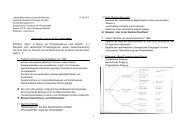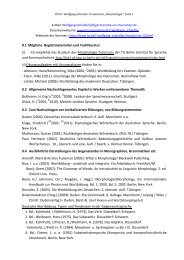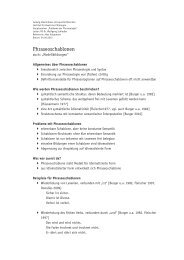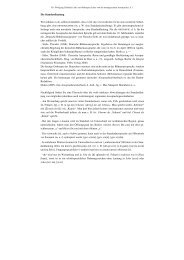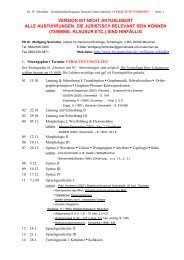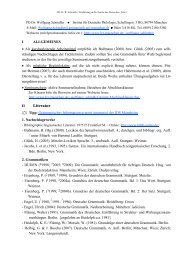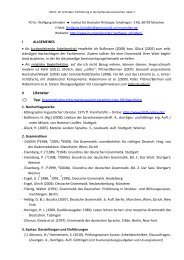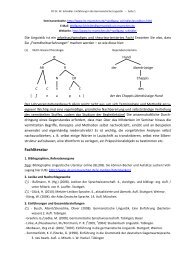Chapter 18 Lexical Functions: Description of Lexical Relations in a ...
Chapter 18 Lexical Functions: Description of Lexical Relations in a ...
Chapter 18 Lexical Functions: Description of Lexical Relations in a ...
Create successful ePaper yourself
Turn your PDF publications into a flip-book with our unique Google optimized e-Paper software.
Def<strong>in</strong>ition <strong>18</strong>.3: <strong>Lexical</strong> Function<br />
—<strong>Chapter</strong> <strong>18</strong>. <strong>Lexical</strong> <strong>Functions</strong>— 16<br />
A correspondence f that associates a set f(L) <strong>of</strong> lexical expressions with an LU L is called a<br />
<strong>Lexical</strong> Function [= LF] iff it satisfies either conditions A1-A3 or condition B.<br />
A. f is applicable to several LUs and:<br />
1. Semantic homogeneity <strong>of</strong> f(L)<br />
For any two different LUs L1 and L2, if f(L1) and f(L2) both exist, then any L´1 ∈ f(L1) and<br />
L´2 ∈ f(L2) bear an (almost) identical relationship to L1 and L2, respectively, as far as<br />
their mean<strong>in</strong>g and the DSynt-role are concerned:<br />
2. Maximality <strong>of</strong> f(L)<br />
L´1 L´2<br />
—— ≈ ——<br />
L1 L2<br />
For any two different LUs L´1 and L´2, if L´1 ∈ f(L1) and L´2 ∉ f(L2), then L´2 does not<br />
stand to L2 <strong>in</strong> the same relationship as L´1 to L1:<br />
3. Phraseological character <strong>of</strong> f(L)<br />
a) At least <strong>in</strong> some cases f(L1) ≠ f(L2); and<br />
L´1 L´2<br />
—— ≠ ——<br />
L1 L2<br />
b) at least for some f(Li) some elements <strong>of</strong> f(Li) cannot be specified without mention<strong>in</strong>g<br />
an <strong>in</strong>dividual LU Li.<br />
B. f is applicable to only one LU L (or perhaps to a few semantically close LUs).<br />
In f(L), the LU L, which is the argument <strong>of</strong> f, is called the keyword 5 <strong>of</strong> f, and f(L) = {L´i}<br />
is f’s value.<br />
An LF that is applicable to several LUs—satisfy<strong>in</strong>g Conditions A1-A3—is called normal;<br />
an LF applicable to only one LU (or two or three semantically close LUs)—satisfy<strong>in</strong>g Condition<br />
B—is degenerate. (Degenerate LFs are an extreme case <strong>of</strong> non-standard LFs, see 4.5.2, p.<br />
00.)<br />
Thus, a normal LF f specifies for its keyword L a set <strong>of</strong> lexical expressions<br />
f(L) = {L´i | 1 ≤ i ≤ n} SYNTAGM<br />
such that:<br />
• all its elements stand to L <strong>in</strong> (almost) the same semantic/syntactic relation R;<br />
• it <strong>in</strong>cludes all the expressions that bear the relation R to L;


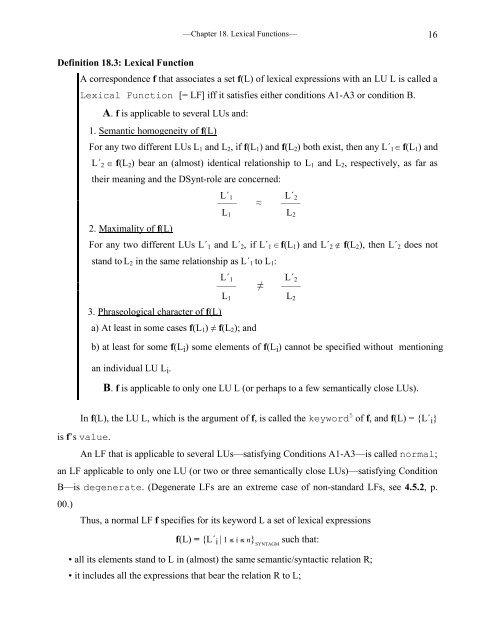
![E-Mail: Wolfgang.Schindler[ätt]germanistik.uni-muenchen.de Web ...](https://img.yumpu.com/51590147/1/184x260/e-mail-wolfgangschindlerattgermanistikuni-muenchende-web-.jpg?quality=85)
